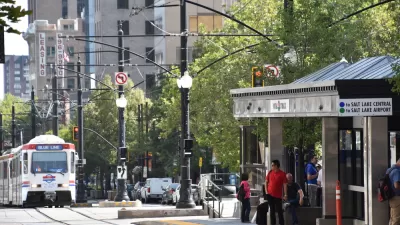A bill introduced in the Utah State Legislature would curtail the UTA's ability to partner in new transit oriented development projects.

A bill introduced by Utah State Senator Wayne Harper is seeking to reshape how the Utah Transit Authority (UTA) currently does business. Lee Davidson of The Salt Lake Tribune reports that the bill would reduce the number of UTA commissioners from 16 to eight, create a citizen advisory committee, and block the UTA from entering into new development deals for transit oriented development.
The bill proposes to ban UTA from entering into partnerships for more transit-oriented developments beyond eight previously approved by the legislature, and would require formal cost-benefit analyses of ones in the works to show that investment in them benefits the public and would improve transit service.
In such developments, UTA usually uses excess land it owns at rail stations to partner with developers for residential and commercial projects designed to increase transit ridership. But audits have criticized sweetheart deals for some developers and building large garages for their projects that sat mostly empty for years because of developer delays.
In the article, Harper notes that due to a potential drop-off in federal funding for transit projects, competition for funds with highways, bike paths, and pathways will require additional need for coordination. Other bills in the legislature are seeking to limit the ability of UTA employees to unionize.
FULL STORY: Bill would change UTA board, ban new 'transit oriented development,' create citizen advisory council

Planetizen Federal Action Tracker
A weekly monitor of how Trump’s orders and actions are impacting planners and planning in America.

Congressman Proposes Bill to Rename DC Metro “Trump Train”
The Make Autorail Great Again Act would withhold federal funding to the system until the Washington Metropolitan Area Transit Authority (WMATA), rebrands as the Washington Metropolitan Authority for Greater Access (WMAGA).

The Simple Legislative Tool Transforming Vacant Downtowns
In California, Michigan and Georgia, an easy win is bringing dollars — and delight — back to city centers.

The States Losing Rural Delivery Rooms at an Alarming Pace
In some states, as few as 9% of rural hospitals still deliver babies. As a result, rising pre-term births, no adequate pre-term care and "harrowing" close calls are a growing reality.

The Small South Asian Republic Going all in on EVs
Thanks to one simple policy change less than five years ago, 65% of new cars in this Himalayan country are now electric.

DC Backpedals on Bike Lane Protection, Swaps Barriers for Paint
Citing aesthetic concerns, the city is removing the concrete barriers and flexposts that once separated Arizona Avenue cyclists from motor vehicles.
Urban Design for Planners 1: Software Tools
This six-course series explores essential urban design concepts using open source software and equips planners with the tools they need to participate fully in the urban design process.
Planning for Universal Design
Learn the tools for implementing Universal Design in planning regulations.
Smith Gee Studio
City of Charlotte
City of Camden Redevelopment Agency
City of Astoria
Transportation Research & Education Center (TREC) at Portland State University
US High Speed Rail Association
City of Camden Redevelopment Agency
Municipality of Princeton (NJ)




























